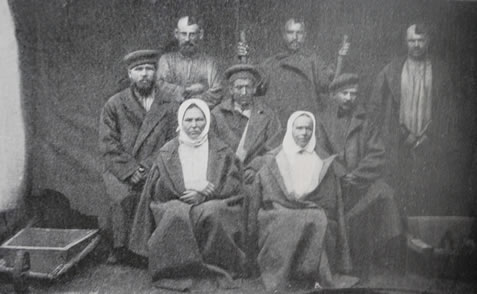| Annual Newsletter of the Slavic Research Center, Hokkaido
University |
Japanese English |
-->List
of All Publications-->Annual
Newsletter-->no.17 |
|
| No.17, January 2010 |
|||
| Our Current Staff |
Ongoing Cooperative Research
Projects |
Visitors from Abroad |
Guest Lectures from Abroad |
Publications (2008-09) |
The Library |
Website Access Statistics |
| Essays by Foreign Fellows |
||
| Andrew Gentes |
Dariusz Kołodziejczyk |
Marina Mongush |
The Salience of the Sakhalin Penal Colony
Andrew Gentes (University of Queensland, Australia/foreign fellow, SRC, 2009–10)
*Andrew Gentes, Dariusz Kołodziejczyk, and Marina Mongush were Foreign Visiting Fellows at the Slavic Research Center in 2007–2010. The views of the authors show the breadth of the SRC's interests, but are the authors' own.
During the final decades of the Romanov dynasty Petersburg tried to turn Sakhalin Island into a serviceable carceral, to take advantage of what was seen as a geographically predisposed prison surrounded by a moat which, to the east, was formed by the broad Pacific Ocean and, to the west, by the narrow Tatar Straits. Several factors explain Russia's efforts to force Sakhalin to play this role, one of the most important being that it was considered to be escape-proof, in contradistinction to the settlements and labor sites that exiled criminals were assigned to on the Siberian mainland. Sakhalin did turn out to be difficult, though certainly not impossible, to escape from.
 |
| Vlas Doroshevich |
Nonetheless, the major goal determining Sakhalin's initial function as a penal colony, that it would eventually become an imperial colony of "free" Russian settlers similar to the same way Australia had for the British Empire, was never realized prior to 1917. First, most convicts failed to meet the requirements needed to become a "peasant-former-exile"”; second, those who did achieve this status chose more often than not to exercise their new right to leave the island and its population of egregious offenders and to relocate to the mainland, not only to escape Sakhalin's military administration, rapacious factory owners, and quotidian thefts and murders, but also to ensure a better chance of survival, since the insalubrious combination of geography and climate rendered agriculture there as difficult as drawing blood from a turnip.
Anyone who has read the accounts by Chekhov, Doroshevich, Hawes, Howard, or others who visited the island, or those by Gotskevich, Ermakov, Shirokolobov, or Iuvachev, each of whom was exiled there, already has a pretty fair idea of what a hell-hole the penal colony was until the 1905 Japanese invasion that led to its abolition and Russia's cessation of the island's southern half.
Less appreciated is that Sakhalin helped catalyze a process that was crucial in the capitulation of tsarism, a process that may be summ ed up as the radicalization of Russia's reading public, broadly defined. This process naturally involved the development of literacy and publishing in late imperial Russia. As studies by Eklof and Brooks have shown, by the late nineteenth century a significant proportion of even the peasantry could read, and this expanding market combined with advances in technology, distribution, and education stimulated the publishing industry and pushed it into new areas. In addition to the “thick” journals that had always catered to the intelligentsia, a slew of middle- and low-brow publications, mostly in the form of newspapers, were produced for that sector of the reading public which, though not well educated, managed through its consumption patterns to express a veritable "public opinion."
 |
| Sakhalin convicts (note the men chained to the wheelbarrows) |
Vlas Doroshevich, who wrote in a witty yet accessible way for newspapers and journals in both Moscow and Odessa about the fêtes, foibles, and fools de jour, is the foremost example of that new breed of journalists whose fame and fortune depended upon the so called "boulevard press." � When he traveled to Sakhalin in 1897 he was explicitly trying to emulate Chekhov's visit there seven years before, but also hoped that the feuilletons he sent back to Odesskii listok would appeal to a more educated readership. As it turned out, these feuilletons, collected and first published as a book in 1903, cut across and collapsed various genres: high-, middle-, and low-brow; tragic, satirical, and dramatic; historical, editorial, and prophetic. Perhaps for this very reason, his book Sakhalin (Katorga) proved more popular at the time than Chekhov's Ostrov Sakhalin. Though the latter is today better remembered, it is significant that four editions of Doroshevich's book were produced before 1917, and no fewer than four new editions have come out since 1991.
Doroshevich's work was also popular because it tapped into the demotic reading public's appetite for sensational stories about crime and criminals. Already a seasoned crime reporter, he knew how to give readers what they wanted: his book contains several long digressions – often in the form of interviews with Sakhalin's worst offenders – that spare few details about horrific murders. Nonetheless, most of Doroshevich's book amounts to either an explicit or implicit indictment of the penal justice system and, per tractus, tsarism itself. Indeed, here as well he was feeding a ready appetite, one that significantly differed from but was not wholly unrelated to the other, more sensationalistic, one. Indeed, since Dostoevskii's Zapiski iz mertvogo doma (first published in 1861) there had been several publications on Russia's penological crisis. Sergei Maksimov published his three-volume Sibir´ i katorga soon after Dostoevskii’s roman á clef appeared, and it went through at least three editions prior to 1917. He was followed by Nikolai Iadrintsev's Sibir´ kak koloniia, each of whose two editions detail the exile system's devastating impact on Siberian society. The great Dostoevskii and Chekhov were eventually joined by Tolstoi, whose Voskresenie (1899) primarily concerns the judiciary but also includes chilling scenes of the exile system. Shortly before Voskresenie, P. F. F. Iakubovich's V mire otverzhënnykh was serialized in the journal Russkoe bogatstvo. This fictionalized memoir by a former narodovolets imprisoned at Nerchinsk was nearly as popular as Doroshevich's book, though today is even less known. The English translation I am now working on will hopefully redress this.
Doroshevich, therefore, was riding the crest of a wave of popular interest that was itself becoming radicalized by those who wrote to satisfy it. Whereas criticism of the exile system generally overshadowed that of Sakhalin before 1903, publication that year as well of jurist Nikolai Novombergskii's Ostrov Sakhalin, an historical and highly critical account of the penal colony, and the appearance two years later of A. A. Panov’s even more virulent Sakhalin kak koloniia, turned the penal colony and its human rights violations into a cause célèbre that helped rally popular opposition against the regime. So powerful was these books' impact that Sakhalin remained a leitmotif of tsarism’s tyrannical excesses long after 1905.
All of which highlights certain islands' reflexive impact. As salient outposts, islands may at first appear discrete, cut off from developments on the imperial mainland; but their very salience crystallizes and exposes more sharply those tensions afflicting the empire at large. This was certainly the case with tsarist Russia and Sakhalin Island, and may be so of other, more recent, empires and islands.